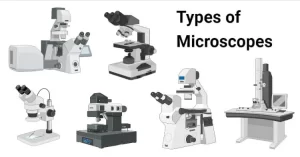What are uses and importance of Microscopes?
Microscopes help scientists study microorganisms, cells, crystalline structures, and molecular structures, They are one of the most important diagnostic tools when doctors examine tissue samples.
Microscopes
The microscope is a laboratory instrument used to examine objects that are too small to be seen by the naked eye, Microscopy is the science of investigating small objects and structures using the microscope, Microscopic means being invisible to the eye unless aided by a microscope.
A microscope is an instrument that allows us to see objects that are too small to be observed with the naked eye. They use lenses or a beam of electrons to magnify the image of a specimen. Microscopes have revolutionized our understanding of the world around us, allowing us to see the building blocks of life (cells), the circulation of blood in our bodies, and the intricate details of snowflakes.
There are many types of microscopes, The most common microscope is the optical microscope, which uses lenses to refract visible light that passes through a thinly sectioned sample to produce an observable image. Other major types of microscopes are the fluorescence microscope, electron microscope (both the transmission electron microscope and the scanning electron microscope), and various types of scanning probe microscopes.
Light microscopes use visible light to magnify an object. They are the most common type of microscope and are used in a wide variety of fields, including biology, medicine, and industry. Light microscopes can magnify objects up to about 2,000 times.
Electron microscopes can magnify objects up to millions of times and are used to study very small objects, such as viruses and atoms. They use a beam of electrons to magnify an object. They can achieve much higher magnifications than optical microscopes.
Microscopes have played a vital role in scientific discovery. They have allowed us to see the world in a whole new way and have helped us to understand the workings of life and the universe. They can be used in many fields such as:
- Biology: Microscopes are essential for studying cells, tissues, and organisms. They are used to diagnose diseases, develop new drugs, and understand how life works.
- Medicine: Microscopes can be used to diagnose diseases, such as cancer and infectious diseases. They are used to monitor the progress of treatment.
- Materials science: Microscopes can study the structure of materials, such as metals, ceramics, and polymers.
Importance of Microscopes
Microscopes have opened up a whole new dimension in science, By using Microscopes scientists were able to discover the existence of microorganisms, study the structure of cells, and see the smallest parts of plants, animals, and fungi.
Electron microscopes help create the very tiny electrical circuits found on Silicon microchips, Scanning microscopes are much more sophisticated, and they have higher magnifications than light-refracting microscopes.
Microscopes are used to diagnose illness in hospitals and clinics all over the world, Microscopes magnify the blood samples, so, doctors can see the malaria parasites attacking the red blood cells.
Microscopic examination confirms the laboratory tests that may be positive for the disease, Technicians count the number of red blood cells infected with malaria to give the doctors an idea of how advanced the disease is in a patient.
Microscopes use simple visible light refracting lenses, Electrons, x-rays, and infrared rays, They are to detect smaller and smaller structures, Scanning electron microscopes can resolve viruses that are far smaller than any cell, and they enlarge the view of tiny viruses, which allows scientists to develop the vaccines and cures for infectious diseases in the humans and the animals.
Scanning electron microscopes have magnifications up to several million times to view molecules, viruses, and the nano-particles, They use corrective software to increase the magnification and the resolution of images, The computers help the nano-technologists use high-powered electron microscopes to view objects with only a few molecules thick.
Electron microscopes help prepare the small surfaces for sectioning into small slices, Microscopes enlarge the images of silicon chips to help the engineers create more efficient electronic devices, When more circuits are fitted onto a small chip, the computational power of silicon microchips increases.
Optical or light microscopes are the most commonly used and the oldest type of Microscopes, Where the light is passed through the machine and through the specimen being viewed to magnify it, They use a specialized camera to produce a film or even a digital image, The stains are used on the glass slide to make the cells or the structures more easily seen.
Electron microscopes use beams of electrons rather than light to create an image, They are used to visualize objects such as microorganisms and crystal structures that are too small to be imaged with an optical microscope.
Probe scanning microscopes are used to create images of objects that are rather flat, They use a probe that scans the object’s surface, and then the software is used to render the results into a viewable image.
Virtual microscopy uses computer technology to convert the images on the glass slides into electronic data that has a resolution similar to that achieved with the use of an optical microscope, This technique enables the electronic transport and the storage of data from the slides, and also it allows the slides to be reviewed remotely.
Microscopes are used in viewing specimens that are relatively very small in size, they are used to view the cellular structures of organs, germs, and bacteria, They play a very important role in the laboratory for the tissues and organisms that are too small to be seen clearly with the naked eye.
All branches of biology use Microscopes, especially in Molecular Biology and Histology (the study of cells), Microscopes are the backbone of studying biology, biologists use them to view the details that cannot be seen by the naked eye such as the small parasites and small organisms which is important for the disease control research.
Light microscope and Electron microscope
Compton effect, Photon properties, Electron microscope and Optical microscope
Forensic pathology, Digital imaging and telepathology, Microscopes in clinical pathology





You have explained well
Thank you very much for your comment
This helped me alot
thanks for this informaion
You are welcome
Thank you very much for your comment
What is the application of microscope in Biochemistry and clinical pathology?
The microscopes are best for viewing bacteria and blood cells , The pathologist makes macroscopic examinations of tissues removed during surgery or after death, examine tissue slices under the microscope, examine exfoliated cells , analyze body fluids for abnormal levels of chemicals and / or the presence of crystals (using polarizing microscopy), and carry out molecular studies to diagnose disease , Histological staining techniques are central to identifying abnormal cell and tissue morphology under the light microscope.
Thnx…. For this.. Information this help me a lot…. Without… That I can’t do.. Anything
You are welcome
Thank you very much for your comment
Tqq.. N it helped to do my assignment
You are welcome
Thank you for your comment
this helped me so much with my project
Thank you for your comment
what is the purpose of an optical microscope?
Functions of the light microscope:
Magnifying many micro-organisms and non-living things.
Examining large-sized objects after cutting them into very thin slices that allow the light to transmit through them.
You can read articles about optical microscope
Light microscope and Electron microscope
Compton effect, Photon properties, Electron microscope and Optical microscope